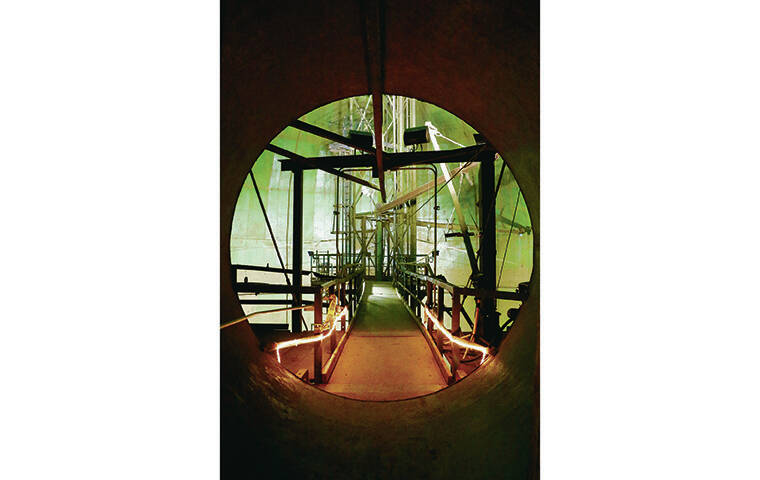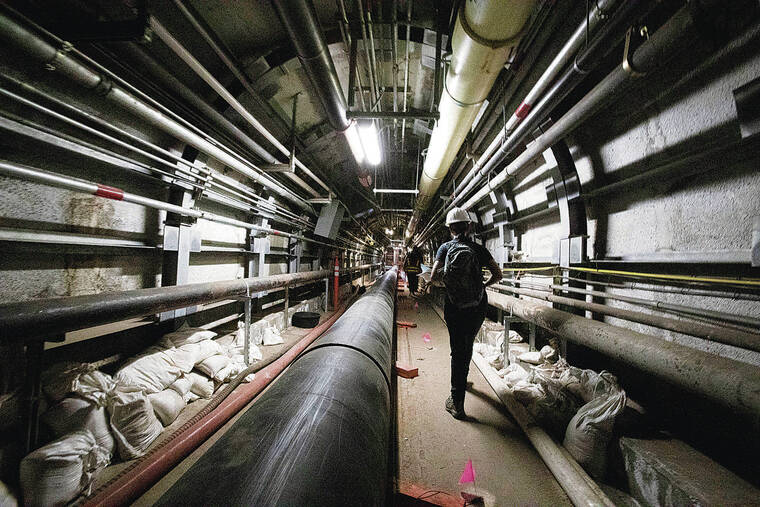Pentagon speeds up timeline for defueling Red Hill by several months

U.S. NAVY / 2019
The Pentagon ordered the permanent closure of the Red Hill Bulk Fuel Storage Facility earlier this year after a fuel leak contaminated the Navy’s Joint Base Pearl Harbor-Hickam drinking water system. Pictured is the entrance to Tank 19 at the facility.

CINDY ELLEN RUSSELL / JAN. 28
The U.S. Department of Defense said today it has sped up its timeline for draining the Navy’s underground Red Hill fuel tanks by about five months. Shown here, Navy officials lead a media tour of the Red Hill Shaft in Halawa in January.


The U.S. Department of Defense has sped up its timeline for draining the Navy’s underground Red Hill Opens in a new tab fuel tanks by about five months and now expects that the work can be completed by July 2024.
The projection is part of the military’s supplemental defueling plan submitted to the Hawaii Department of Health on Wednesday, which also discloses for the first time that there are 1 million gallons of fuel sitting in its Red Hill pipelines that it plans to remove next month.
The DOD had essentially missed its original June 30 deadline set by the DOH, submitting a 20-page defueling plan that military officials acknowledged at the time was inadequate.
The DOH rejected that plan Opens in a new tab due to its lack of details, saying that it was “like turning in a homework assignment you know is incomplete just to meet a deadline.”
The new 39-page supplemental plan is also lacking. The Pentagon said it expects to submit additional information to DOH later this month that will include analysis from additional studies that it didn’t receive in time to incorporate, including two inspection reports from the U.S. Environmental Protection Agency.
The Pentagon had previously estimated that it would take until the end of 2024 to defuel the tanks, citing needed infrastructure repairs, staff training and supply chain disruptions. The Hawaii Sierra Club and Honolulu Board of Water Supply, as well as political leaders, expressed alarm at the lengthy timeline, saying it raised the risk of more leaks.
Don't miss out on what's happening!
Stay in touch with breaking news, as it happens, conveniently in your email inbox. It's FREE!
The Defense Department said it was able to shorten the estimated time by condensing the repair timeline, finding activities that could be done simultaneously and reducing the final phase when the tanks would actually be drained from eight months to about five months. The plan includes details about how it can safely remove the fuel from its pipes, an update on its infrastructure repairs, training improvements and comments addressing the DOH’s feedback from the first report.
“This plan represents considerable work by our DOD and Navy team along with the regulators, and we remain completely focused on the safe and expeditious defueling of the facility,” said Rear Adm. Steve Barnett, commander, Navy Region Hawaii, in a news release. “As we move forward, we will continually refine and improve this plan, and keep stakeholders and the community informed throughout the process. Every action we take must protect the environment and the community.”
The Pentagon ordered the World War II-era fuel facility to be permanently shut down earlier this year after a fuel leak contaminated the Navy’s Joint Base Pearl Harbor-Hickam drinking water system, sickening military families and spurring widespread political and community opposition to its continued operation. But draining the tanks hasn’t proved simple.
An independent assessment Opens in a new tab of the facility released in May found that the facility would need to undergo extensive repairs in order for the fuel in the massive underground tanks to be drained safely and to prevent a catastrophic release that could further pollute the groundwater, cause a major fire or potentially injure or kill workers.
Of the 43 categories of repairs outlined in the assessment, only five have been completed, according to the Navy’s supplementary report. An additional 30 recommended repairs are in various stages of execution.
The majority of needed repairs are on the Red Hill distributions system. The independent assessment found deteriorating and aging pipelines, corrosion and faulty valves, among many other problems.
The Navy is now planning to remove the fuel that has been sitting in the pipelines since last year, when Red Hill operations ceased.
Despite the alarming condition of the pipelines, the Pentagon’s report says that draining the fuel will be “relatively low-risk” because it involves no external pressure in the lines and no movement of fuel from the tanks. Draining the pipelines is expected to be completed in a matter of hours, according to the Pentagon’s report, and be done in October.
The Pentagon is planning a Sept. 22 exercise to simulate its response in the event of a worst-case spill from the pipes.
The major defueling of the facility isn’t planned to begin until 2024 when the Navy starts draining 104 million gallons from 14 tanks.
The Pentagon is preparing to move that fuel to the mainland and another fuel storage facility in West Oahu. While the report doesn’t name the Oahu facility, state officials have discussed using facilities maintained by fuel refinery and distribution company Par Hawaii.
The military is planning to transport some of the jet fuel to the mainland, using a tanker with a 10.5 million-gallon capacity to conduct three round trips, according the report. Each trip is expected to take about 45 days. The Department of Defense plans to contract with a second tanker, with the same capacity, to move the rest of the fuel to the West Oahu facility.
The DOH said it will comment on the plan once it has finished reviewing it, while stressing that the tanks need to be drained as quickly and safely as possible.
“There is a continued threat to our aquifer and residents every day that fuel remains in the Red Hill tanks,” DOH Deputy Director of Environmental Health Kathleen Ho said in a statement. “As we review this submission, it is our full expectation that it will have the requisite amount of detail to ensure defueling work can begin.”
Hawaii’s U.S. Sen. Brian Schatz said in a statement that shutting down the facility cannot be delayed and that a joint task force that DOD said will be overseeing the defueling needs to be in place.
“While the updated plan to close the facility sooner is a step in the right direction, DOD must make it a priority to move fast and permanently shut down Red Hill as quickly as possible,” he said. “We also need the Joint Task Force to become fully operational. That means the Secretary of Defense must act quickly and name its commander, a role that will serve as DOD’s on-the-ground leader responsible for working with state and local officials to safely defuel the tanks.”
———
ON THE NET:
>> The Pentagon’s supplemental defueling plan can be read at 808ne.ws/pentagonplan Opens in a new tab



